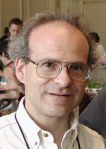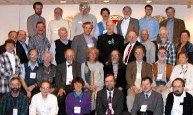danbricklin.com/log
|
||
|
|
Starting October 31, 2000
Great interest in usability, Usability matters, DNS Problems, Professor Lessig on Intellectual Property, A fond goodbye to Multics
31Oct00-10Nov00
2000_10_31.htm
|
|
Friday, November 10, 2000
Great interest in usability
I've seen an enormous amount of interest in the Florida ballot usability story: lots of links to this web site, emails, interviews with reporters, a local TV station's camera crew visiting our usability lab, and more.
This is great. Usability is finally in the public's consciousness. Hopefully, people will have a greater appreciation for well designed products.
When you think about appearing in a debate, everybody remembers the story of Nixon with his 5 o'clock shadow and sweat from 40 years ago, the classic example of subtle visual cues. Now, whenever people encounter something a bit confusing they can think of the Palm Beach Ballots -- the classic example of subtle usability problems.
Our K-12 teachers have a wonderful opportunity. The 2000 election encompasses civics (Electoral College), strategy (same), statistics (Palm Beach), usability and graphic design (same), journalism (early returns reports), and more. These all involve skills in critical thinking that we'll need in the workforce of the future. And, just think, education was high on the agenda of both major candidates.
Over the last day or so I've made a few additions to Ballot Usability in Florida. If you read it when I first posted it, check again.
Wednesday, November 8, 2000
Usability matters
Jakob Nielsen has been insisting for years that usability is real important. Edward Tufte has shown lots of examples in print. I've written here about how important we feel it is at Trellix Corporation. Well, now we have a new, about-to-be-a-classic example: Did usability affect the voting for President in Florida?
Read: Ballot Usability in Florida (Updated several times during the day and evening Wednesday)
I have heard from a variety of people about voting instrument confusion in many states, not just near West Palm Beach Florida. We know from lots of examples of usability studies that errors on tasks arising from "dumb mistakes" are very common, with rates of easily 5%, 10%, or more. Elections are often decided by much slimmer margins than that. In our ever-mobile world, thorough testing of ballot techniques and standardization may be called for if we are to believe that we truly choose our elected officials rather than flip a coin.
Monday, November 6, 2000
DNS Problems
Bob Frankston has started pointing out some more problems with our current use of the DNS (Domain Name System) and all the politics and business models that surround it.
 Bob at Agenda last month
He points out that not only does the individual lose the use of a name because of trademark, legal, or payment problems, but also all of society loses access to the knowledge.
The real problem is that the domain (“dot-com”) names have no permanence and one must be vigilant in order to keep the names valid. If one takes no action the name lapses and is either reused or simply becomes invalid. This can have serious and even tragic consequences. It's one thing to discover the film used to make movies in the 1970's is deteriorating. It's another thing to entrust much of our knowledge and societal memory to a mechanism that is certain to decay. It is the inverse of copyright — after the name expires your work is effectively destroyed instead of being made more widely available.
We must provide a permanent naming system rather than the current DNS.
- Bob Frankston
Much of the value of the Web is in the links. There is no other information at the linking site other than the URL which includes a domain name. If, for any reason, the actual address changes, the links become invalid and useless. There is no "permanent" directory to look at. Most pages are not indexed by search engines and the cost to re-link would be prohibitive. The people hurt are not just the domain name holders but also all potential readers and the Web itself. In today's world all it takes is missing a payment to the Domain Registrar to break links forever -- you may not be able to get your old domain name back. Making the integrity of links be at the whim of lawyers, lawmakers, and businesses as it is today is like building the Library of Congress on stilts out in the ocean in a hurricane zone -- poor planning.
This is all distinct from the Directory Lookup problem (does "www.ford.com" refer to the car, the actor, the foundation, the president, the city, the theater, etc.). This is about permanent links after you've found what you want to link to.
Read Bob's paper and suggestions for fixing the problem:
DNS: A Safe Haven for URLS and Internet Identifiers by Bob Frankston
Thursday, November 2, 2000
Professor Lessig on Intellectual Property
If you haven't seen Professor Lessig's article in The Industry Standard about the difference between Intellectual "Property" and "real" property (Dan Gillmor pointed to it the other day), you should. Very interesting. Here's an excerpt:
Intellectual property is, and has always been understood to be, different from ordinary property...The framers [of the US Constitution] distinguished these forms of "property" not because they were latent communists. They distinguished between real and intellectual property because they understood that the physics of real property were different. If you take my horse, I can't ride it. But if you take my idea, I am still free to use it, just as, as Thomas Jefferson himself said, "he who lites [sic] his taper at mine, receives light without darkening me." This difference means the regulations necessary to protect intellectual property are different from those needed to protect ordinary property.
- Lawrence Lessig, October 30, 2000
Read the full article. Professor Lessig also has a web site with other writings.
Tuesday, October 31, 2000
A fond goodbye to Multics
Today I received a copy of an email from Prof. Corbato of MIT commenting on the shutting down of the last instance of hardware running the Multics system. That installation should be shutting down, after 18 years of service, as I write this.
Multics was an operating system whose development started in the mid-1960's. I worked on it from January 1970 until August 1973. I met important people in my life, like my old partner Bob Frankston and friend David Reed, as part of that work. The original code for VisiCalc was written by Bob using tools running on an MIT Multics system in 1979. My involvement with the system and its development team is a major influence on my work to this day.
I still remember walking around the Laboratory for Computer Science at MIT as a freshman in late 1969 and poking my head in offices looking for a job. Corby (as Prof. Corbato is known) welcomed me with open arms and showed me how to sign up. What a thrill: Me, the lowly freshman, and he, the famous computer scientist I had read about in Scientific American. That turned out to be one of the most important unplanned moments in my life, affecting all that followed.
  Some of the Multics team in April 1999, Prof. Corbato who led the project (he was also Frankston's thesis advisor)
Multics is probably best known as the basis for the architecture of UNIX (and now Linux). Thompson, Ritchie, Kernighan, and others who developed UNIX first worked on Multics and developed many of their ideas in the context of Multics before being forced to create another, simpler system.
For more information about Multics, see the Multics General Information page. To learn more about the relationship with UNIX, see "Multics and UNIX".
|
||
|
© Copyright 1999-2018 by Daniel Bricklin
All Rights Reserved.
|
||
